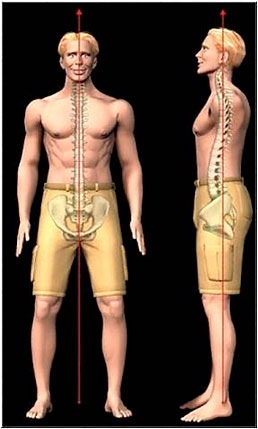We’ve all heard it: “Sit up straight!” from our mothers at one point in our life. We would sit very miliatry-like and could only hold it for a few seconds. Do you feel the same way now? What exactly is good posture and can it be for more than good looks?
 Let’s start at the base, our pelvis. The spine is attached at the pelvis (Sacral Iliac Joint), and is thus very influenced by your deep core muscles and posture. You need to have a strong core in order to hold your pelvis in its neutral position. Not with your butt stuck out, and not so that your back is flat – somewhere half way in between. Once your pelvis is neutral, your lower back needs to have a small lordotic curve. This provides shock absorption for your spine. If you insist on walking around with your lower back completely flattened, you lose that valuable spring in your movements.
Let’s start at the base, our pelvis. The spine is attached at the pelvis (Sacral Iliac Joint), and is thus very influenced by your deep core muscles and posture. You need to have a strong core in order to hold your pelvis in its neutral position. Not with your butt stuck out, and not so that your back is flat – somewhere half way in between. Once your pelvis is neutral, your lower back needs to have a small lordotic curve. This provides shock absorption for your spine. If you insist on walking around with your lower back completely flattened, you lose that valuable spring in your movements.
Your thoracic spine (where your ribs meet your vertebra) needs to have a curve also. This time, a very mild kyphotic curve. This continues the “s” shape of the spine for added absorption of movement and shock. This is the curve that can become exaggerated in seniors that is caused by osteoporosis.
Lastly, the neck should have the same curve as the lower back. A small curve oppposite to the thoracic spine. Here lies most of our problems. Many people have too much of a lordotic curve, and many have very little curve at all. If you have too much curvature, it is likely caused by an over kyphotic curve in the thoracic spine. This compensation of the neck helps to keep the eyes level for optimal vision (and we think our bodies aren’t smart!). Having either too much or no curve in the neck causes a lot of neck pain that can last a long time. This is where a therapist needs to step in and work on postural correction.
Finally, I want to touch base on shoulders. Having rounding shoulders with shoulder blades (scapula) that stick out, also causes a lot of problems. When people talk about pulling your shoulders back, it gives the wrong impression. To correct your rounded shoulders, you need to tilt your shoulder blades into your rib cage. A very small movement. Do not squeeze your shoulder blades together, this will cause more neck trouble (something we can talk about later). Having good posture through your shoulders means that your humerus is sitting in the joint in its optimal position. This allows for a greater range of motion (especially being able to lift your arm above your head), allows you to lift heavier weights, and reduces injury during sports and activities in your life.
So, straighten up! Hold your pelvis neutral, maintain a small curve in your lower back, and tilt those shoulder blades into your rib cage. It can be very fatiguing at first to hold, but keep at it. You will see a big difference over time.
For a quick demo on setting your shoulder blades and pelvis, click here. Look at the videos on shoulders and core activation.
Jen Mark BSc., CAT(C), CSCS
Dynamic Living